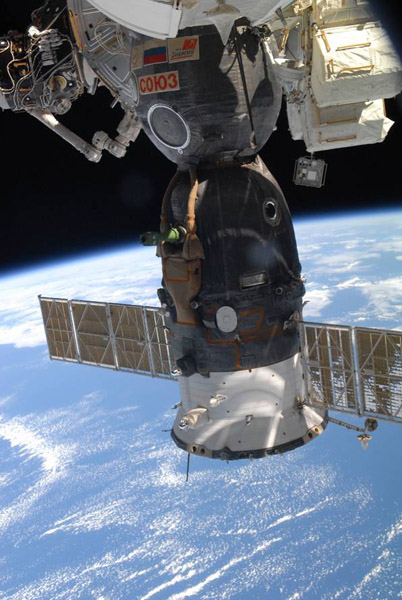A warning of the object's approach came only the night before, too late for the flight controllers to plan a maneuver that would include igniting the station's engines to increase the distance between it and the space debris, but in the end the object passed about 4 kilometers from the station

Yesterday, the people of the control rooms in Houston and Moscow responsible for the International Space Station ordered the astronauts on the station to enter the escape vehicle - a Soyuz spacecraft - due to fear of a collision of the space station with an object coming towards it and approaching it dangerously close.
The three astronauts, two Americans and a Russian, moved into the Soyuz TMA-13 spacecraft anchored at the station at 16:35 GMT (18:35 Israel time), as a safety measure in the event that the fragment - a small piece from a disabled satellite engine - opens a hole in the outer part of the station. Michael Finke, Sandra Magnus and Yuri Lonchakov were ready to evacuate the station if indeed the bone would hit and cause a drop in the air pressure in the station's living areas.
A warning about the approach of the object came only the night before, too late for the flight controllers to plan a maneuver that would include igniting the station's engines to increase the distance between it and the space debris, but in the end the object passed about 4 kilometers from the station - absolutely nothing in space terms and did not hit it. Immediately afterwards, the astronauts returned to the station after a 10-minute stay in the Soyuz spacecraft.
The preliminary assessment was that the risk of injury was not high, but to be on the safe side, it was decided to ask the astronauts to enter the Soyuz, and to close the hatches between the spacecraft and the station, a step that would protect them in the event of an airfall, but they did not detach from the station, although they were ready to do so at any moment if required. The astronauts reported to the control room that they did not see the object, but they are glad that it missed the station.
The object in question is a segment from the engine of an outdated PAM-D rocket that was used in the past to raise satellites from a low orbit around the earth to a geostationary orbit (an orbit at an altitude of 36 km where the communication satellites are placed). It is basically one centimeter long that moves at a speed of about 32 thousand km/h. For comparison, the speed of the space station - 28 thousand km/h.
NASA says that this is not the first time the station has been put on alert. Several times the engines of the Russian section of the station were activated to prevent crises, and once in the past the astronauts also entered the escape space. It was on November 17, 2008 when remnants of an SL-12 missile hovered about 19 miles from the station.
The collision that occurred between a commercial Iridium satellite and a Russian Cosmos satellite on February 10 increased the risk of space debris colliding with the space station and with the space shuttle scheduled to take off on Sunday to the space station by about 6%.
And in the process, NASA began to detect the first falls of fragments from the collision in February, which penetrate the atmosphere and burn up in it.

2 תגובות
Space agency spokesmen said this afternoon that the debris was about 5 inches (12.7 centimeters) in size, which would be larger than the initial estimates of 0.35 inches (9 millimeters)